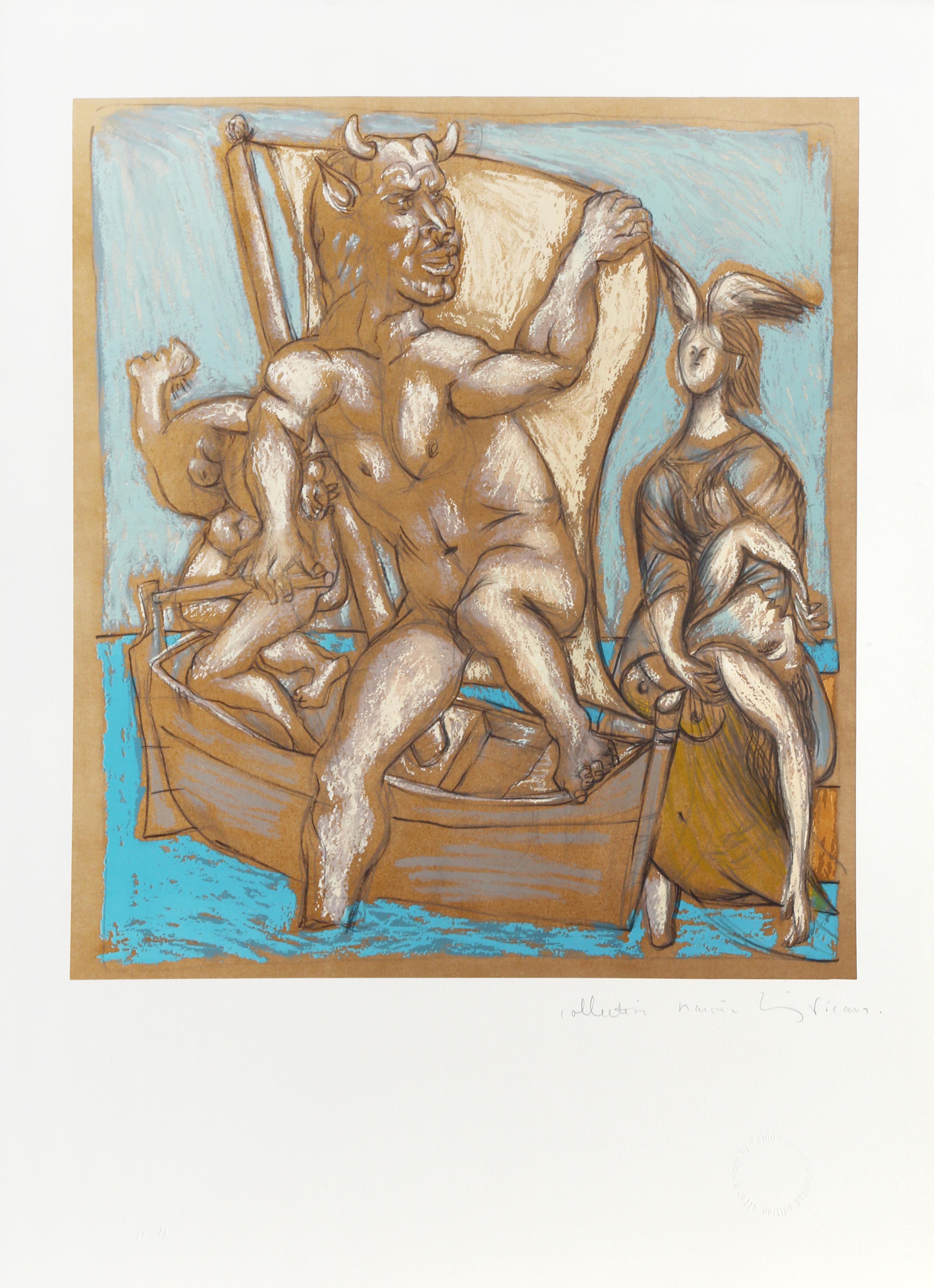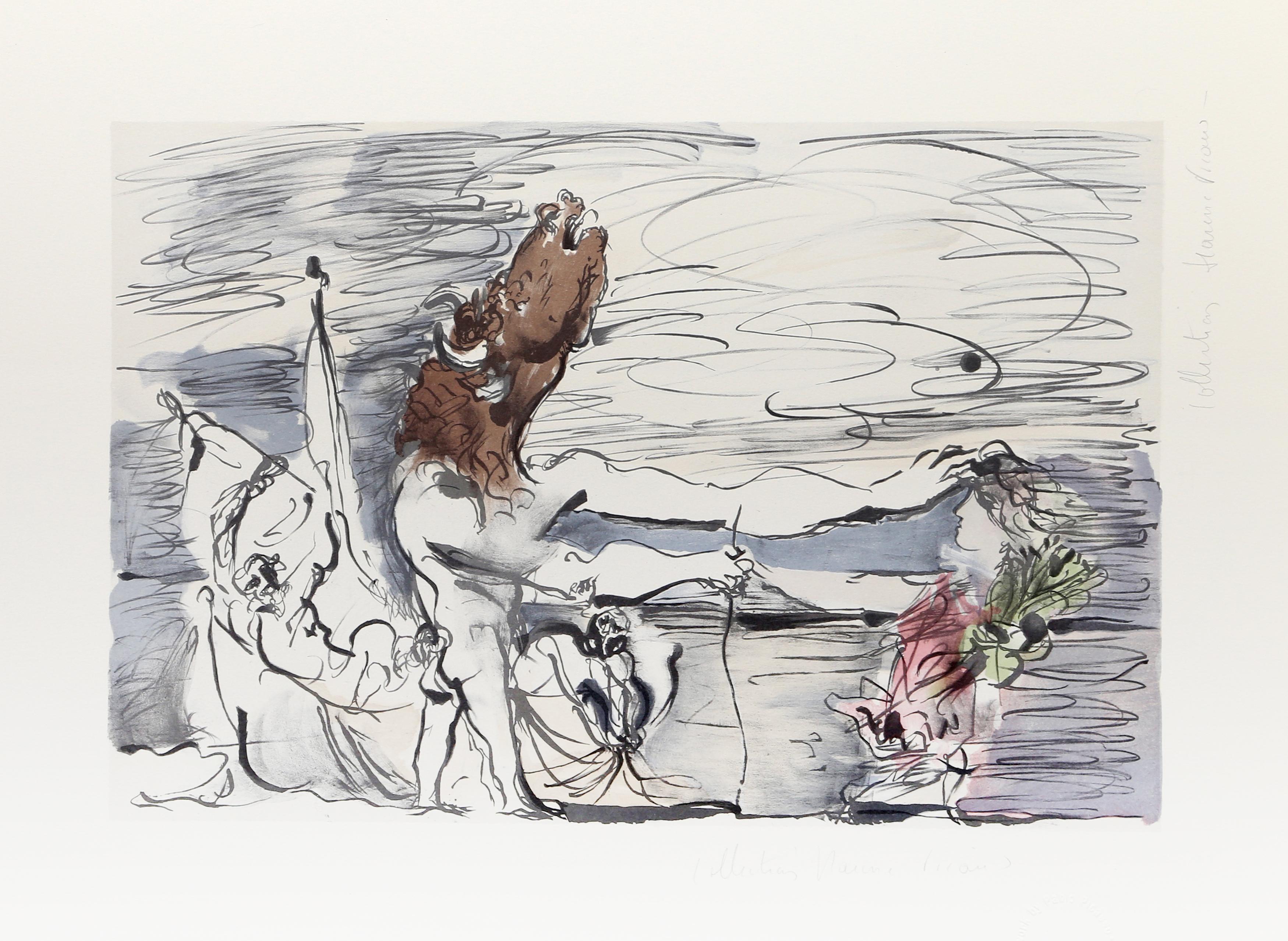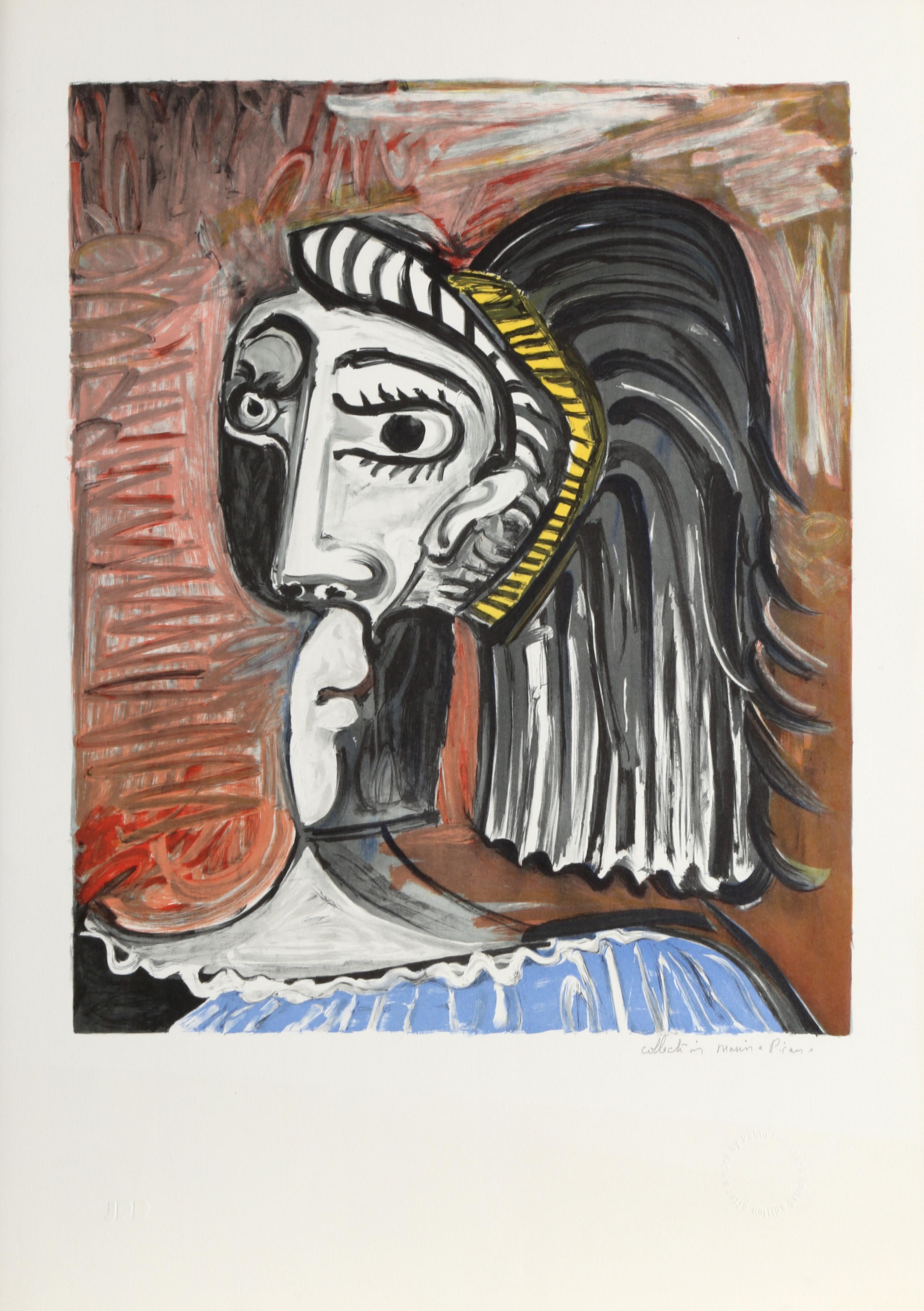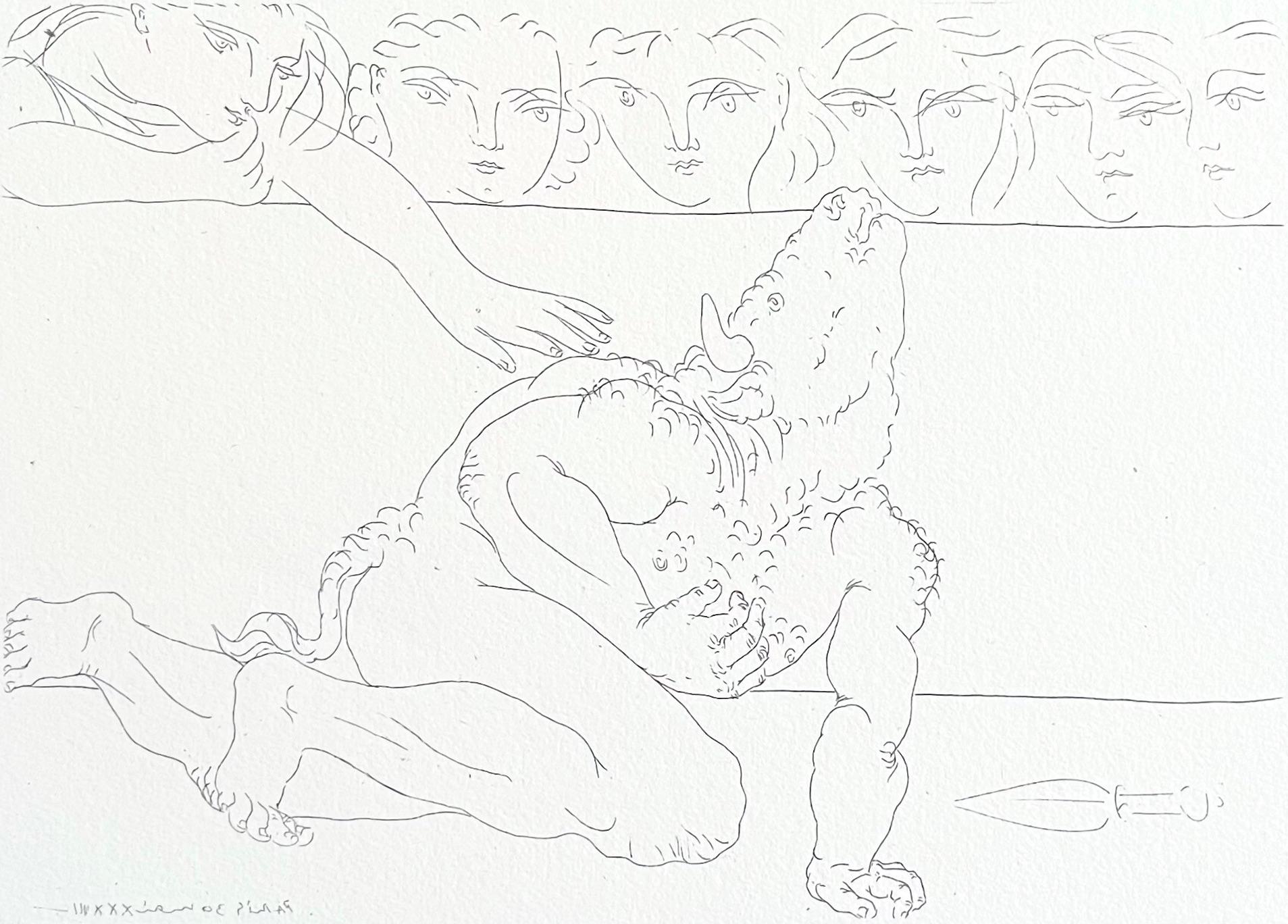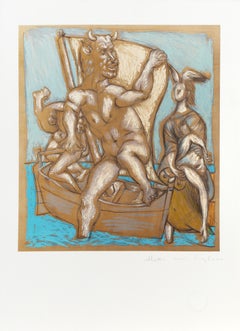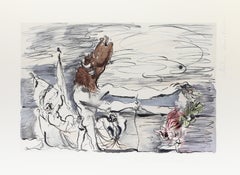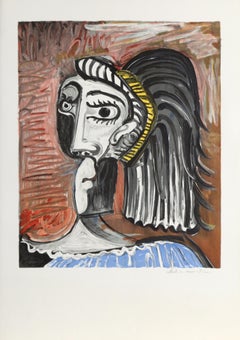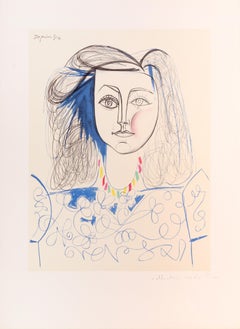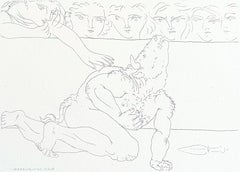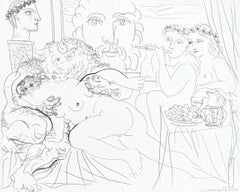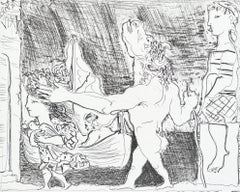Items Similar to Minotaure et Femme
Want more images or videos?
Request additional images or videos from the seller
1 of 7
Minotaure et Femme1982
1982
$8,600
£6,604.43
€7,568.60
CA$12,106.68
A$13,562.15
CHF 7,054
MX$165,430.27
NOK 89,806.86
SEK 84,681.47
DKK 56,489.93
About the Item
Running across an open field shaded by a few trees, the female figure in this Pablo Picasso print passes by a minotaur relaxing in the grass as he lays on his stomach and crosses his legs in the air. Her cape studded with small stars, the woman is shown in soft hues of purple, orange, and yellow, while the minotaur blends into the background of flowing linework.
Minotaure et Femme
Pablo Picasso (After), Spanish (1881–1973)
Portfolio: Marina Picasso Estate Collection
Date: of Original: 1936 Year Printed: 1979-1982
Lithograph on Arches Paper
Edition of 500, unnumbered, 34 AP's
Size: 22 in. x 29 in. (55.88 cm x 73.66 cm)
Printer: Laurent Marcel Salinas (Chromist)
Reference: 18-C
- Creation Year:1982
- Dimensions:Height: 22 in (55.88 cm)Width: 29 in (73.66 cm)
- Medium:
- Movement & Style:
- After:Pablo Picasso (1881-1973, Spanish)
- Period:
- Framing:Framing Options Available
- Condition:
- Gallery Location:Long Island City, NY
- Reference Number:Seller: RO46221stDibs: LU46611734982
About the Seller
4.9
Platinum Seller
Premium sellers with a 4.7+ rating and 24-hour response times
Established in 1979
1stDibs seller since 2014
3,070 sales on 1stDibs
Typical response time: 1 hour
- ShippingRetrieving quote...Shipping from: Long Island City, NY
- Return Policy
Authenticity Guarantee
In the unlikely event there’s an issue with an item’s authenticity, contact us within 1 year for a full refund. DetailsMoney-Back Guarantee
If your item is not as described, is damaged in transit, or does not arrive, contact us within 7 days for a full refund. Details24-Hour Cancellation
You have a 24-hour grace period in which to reconsider your purchase, with no questions asked.Vetted Professional Sellers
Our world-class sellers must adhere to strict standards for service and quality, maintaining the integrity of our listings.Price-Match Guarantee
If you find that a seller listed the same item for a lower price elsewhere, we’ll match it.Trusted Global Delivery
Our best-in-class carrier network provides specialized shipping options worldwide, including custom delivery.More From This Seller
View AllFemme et Minotaure
By Pablo Picasso
Located in Long Island City, NY
In this mythological work, Pablo Picasso depicts a minotaur descending from a boat as it has reached the shore. Facing the viewer, the minotaur and his ...
Category
1980s Cubist Abstract Prints
Materials
Lithograph
$8,900
Minotaure Aveugle Conduit par une Petite Fille
By Pablo Picasso
Located in Long Island City, NY
In this print after Pablo Picasso, the artist depicts a mythological scene in which a little girl leads a blind minotaur. Set against a seascape, the artist’s use of flowing lines and minimal color creates a whimsical and mysterious scene. Estate of Picasso, (Marina Picasso) pencil signature and embossed blind stamp lower right. Ink stamp verso ‘Approved by the heirs of Pablo Picasso’.
Minotaure Aveugle Conduit par une Petite Fille
Pablo Picasso (After), Spanish (1881–1973)
Portfolio: Marina Picasso Estate Lithograph Collection...
Category
1980s Cubist Abstract Prints
Materials
Lithograph
Tete de Femme
By Pablo Picasso
Located in Long Island City, NY
Pablo Picasso's Cubist rendering of a woman wearing her hair in a ponytail is a classic example of the artist's work. Rendered with high-contrast shading, the head of the woman appea...
Category
Late 20th Century Cubist Abstract Prints
Materials
Lithograph
$7,600
Portrait de Femme
By Pablo Picasso
Located in Long Island City, NY
Facing the viewer, the woman wearing a delicately decorated floral blouse with a rainbow-beaded necklace smiles slightly as she looks back at the viewer with large, bright eyes. Her ...
Category
Late 20th Century Cubist Abstract Prints
Materials
Lithograph
$9,400
Femme Endormie, Cubist Lithograph after Pablo Picasso
By Pablo Picasso
Located in Long Island City, NY
This Pablo Picasso print portrays a nude woman who has fallen asleep. The figure reclines backward toward the viewer, resting on her back. The artist's use of flowing line and the br...
Category
Late 20th Century Cubist Abstract Prints
Materials
Lithograph
Femme Couchee, Cubist Lithograph after Pablo Picasso
By Pablo Picasso
Located in Long Island City, NY
Shaded in soft hues of grey and yellow, the woman represented in Pablo Picasso's print is rendered in a Cubist style with flowing lines and forms. With her arms stretched over her head as she rests, the woman's top has fallen and her chest is exposed. A lithograph from the Marina Picasso Estate Collection after the Pablo Picasso drawing "Femme Couchee...
Category
Late 20th Century Cubist Abstract Prints
Materials
Lithograph
You May Also Like
Faune et Femme Nue
By Pablo Picasso
Located in San Francisco, CA
This artwork titled "Faune et Femme Nue" from the portfolio "La Flute Double" published in 1967 is a lithograph on Moulin Richard De Bas paper after artist P...
Category
Mid-20th Century Cubist Nude Prints
Materials
Lithograph
$2,400
Picasso, Minotaure Mourant (after)
By Pablo Picasso
Located in Fairfield, CT
Artist: After Pablo Picasso (1881-1973)
Title: Minotaure Mourant (after Bloch 198)
Year: 1992
Medium: Reproduced from the original edition using the grain Autotype halftone screen pr...
Category
1990s Cubist Nude Prints
Materials
Lithograph
$3,400 Sale Price
20% Off
Picasso, Minotaure Caressant Une Femme (after)
By Pablo Picasso
Located in Fairfield, CT
Artist: After Pablo Picasso (1881-1973)
Title: Minotaure Caressant Une Femme (after Bloch 191)
Year: 1992
Medium: Reproduced from the ori...
Category
1990s Cubist Nude Prints
Materials
Lithograph
Picasso, Minotaure aveugle guidé dans la Nuit par une Petite (after)
By Pablo Picasso
Located in Fairfield, CT
Artist: After Pablo Picasso (1881-1973)
Title: Minotaure aveugle guidé dans la Nuit par une Petite Fille au Pigeon (after Bloch 223)
Year: 1992
Medium: Reproduced from the original e...
Category
1990s Cubist Nude Prints
Materials
Lithograph
$2,920 Sale Price
20% Off
Picasso, Minotaure aveugle guidé par une Fillette (after)
By Pablo Picasso
Located in Fairfield, CT
Artist: After Pablo Picasso (1881-1973)
Title: Minotaure aveugle guidé par une Fillette dans la Nuit (after Bloch 225)
Year: 1992
Medium: Reproduced from the original edition using t...
Category
1990s Cubist Nude Prints
Materials
Lithograph
$4,000 Sale Price
20% Off
Picasso, Composition (Orozco 238), Picasso, La flûte double (after)
By Pablo Picasso
Located in Southampton, NY
Lithograph and stencil on papier a la cuve du moulin Richard de Bas paper, spécialement filigrané pour cette édition. Unsigned and unnumbered, as issued. Good condition. Notes: From ...
Category
1960s Cubist Figurative Prints
Materials
Lithograph, Stencil
$2,636 Sale Price
20% Off
Free Shipping
More Ways To Browse
Purple Cape
Picasso Minotaur Print
Pablo Picasso Minotaur
Kasimir Etching
Luigi Kasimir Etching
Pablo Picasso Dove
Pencil Drawings 80s
Picasso Serigraph
Royal Model Clothing
Saul Steinberg Signed
Back Of Naked Woman Painting
Bad Religion
Circus Ring
Erte Lithographs
Henri Lautrec Circus
Norwegian 1930s
Original Hokusai
Picasso Mother And Child
